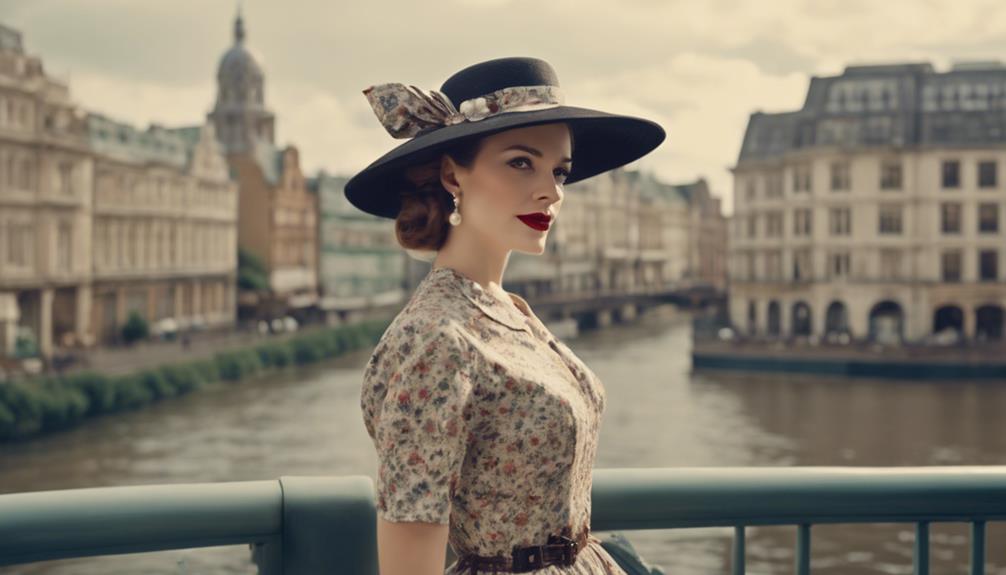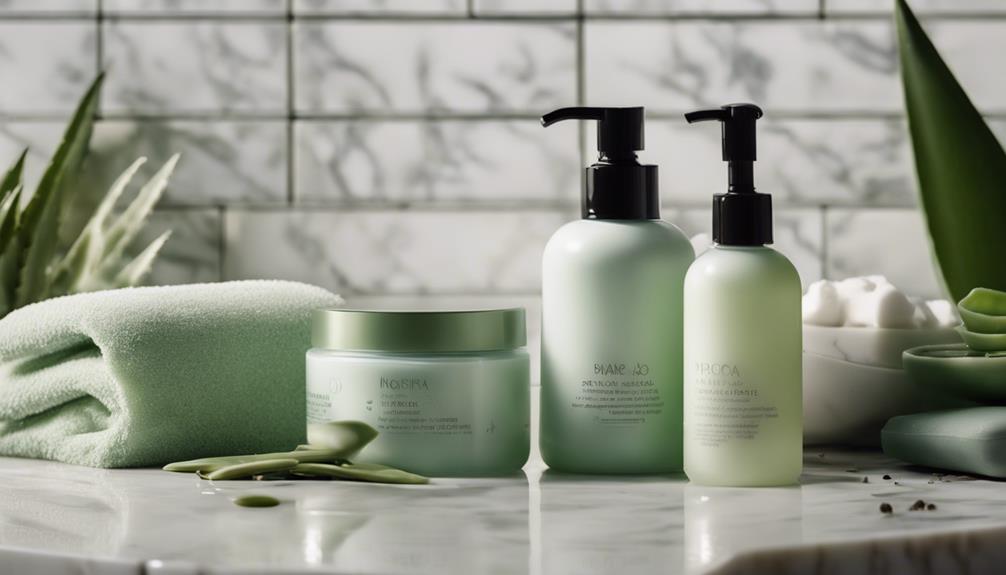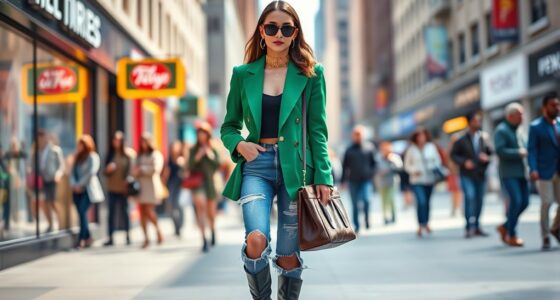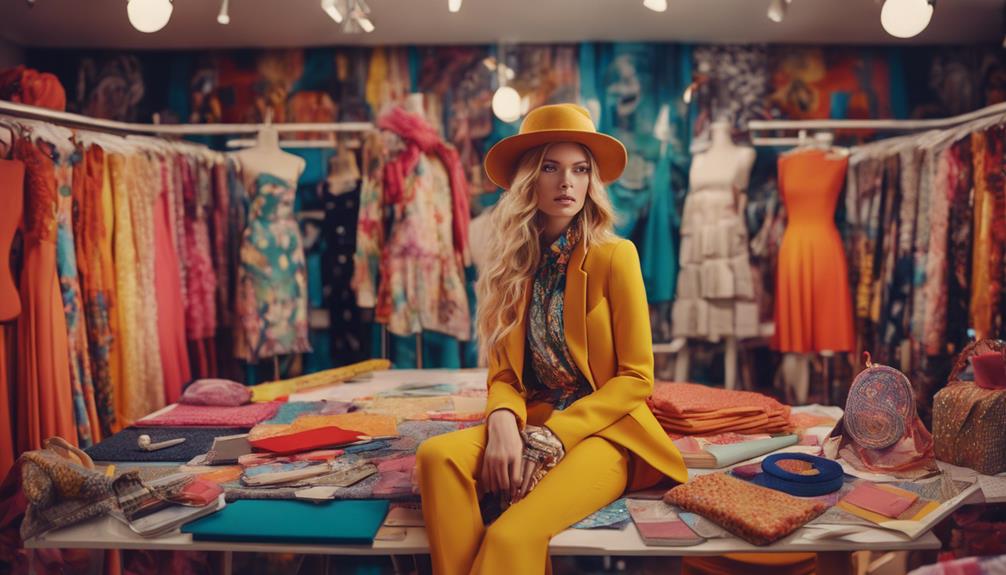Fashion from the 1940s exudes a sense of timeless elegance that continues to inspire today’s trends. Embrace classic silhouettes such as A-line dresses and high-waisted trousers that complement all body types. Mix playful polka dots and bold florals with luxurious fabrics like silk and velvet to add a touch of sophistication to your attire. Elevate your look by accessorizing with timeless pieces like pearl necklaces and structured handbags. Modern interpretations of vintage styles blend retro charm with current trends, keeping the essence alive. If you are interested in shopping tips, styling secrets, and how to incorporate these retro elements into your wardrobe, there is plenty more to discover about the captivating influence of 1940s fashion!
Key Takeaways
- The 1940s introduced iconic silhouettes like A-line dresses and high-waisted trousers, emphasizing femininity and elegance.
- Signature patterns such as polka dots and bold florals added playful charm, making vintage fashion timelessly appealing.
- Luxurious fabrics like silk and velvet created opulent looks, enhancing the sophistication of 1940s styles.
- Timeless accessories, including pearl necklaces and structured handbags, complemented outfits, capturing the essence of retro elegance.
Origin and historical background of the fashion trend/style
In the 1940s, fashion transformed considerably due to world events and cultural shifts.
You'll notice how iconic figures like Christian Dior shaped the era with their innovative designs, introducing styles that redefined femininity.
Understanding these changes helps you appreciate the lasting impact of the decade on today's fashion landscape.
Fashion's Transformation Through Decades
Fashion transforms with each passing decade, reflecting the cultural shifts and societal norms that shape our lives.
As you explore vintage fashion, you'll notice how styles from the 1920s to the 1990s embody timeless elegance and distinct cultural movements. The 1920s flapper dresses with their dropped waistlines symbolized liberation, while the 1940s prioritized femininity through cinched waists and A-line skirts, a response to wartime needs.
Moving into the 1960s, you'll find fashion trends bursting with bold prints and the iconic mini skirt, mirroring the youth culture and social revolutions of the time. The 1970s brought a different vibe, embracing bohemian styles like bell bottoms and flowing maxi dresses, showcasing individuality and counterculture.
Each decade contributed to a cyclical nature in fashion, where retro elements continuously re-emerge, proving that vintage aesthetics hold a lasting influence.
As you look at today's styles, remember that every piece of clothing carries history, and understanding the evolution of fashion can help you appreciate its timeless elegance even more.
Iconic Fashion Icons' Contributions
The influence of iconic fashion figures has shaped trends and styles throughout the decades, leaving a lasting impact on the way we perceive elegance and individuality in clothing.
In the 1950s, icons like Audrey Hepburn and Grace Kelly popularized vintage fashion that emphasized classic silhouettes and luxurious fabrics, embodying timeless elegance.
As you move into the 1960s, Twiggy's mod style and boyish cuts challenged traditional gender norms, introducing bold patterns and colors that invigorated the fashion scene.
The 1970s brought bohemian and disco influences, with figures like Farrah Fawcett and Bianca Jagger showcasing bell bottoms and flowy silhouettes that still resonate today.
The 1980s saw Madonna and Princess Diana embracing vibrant colors and statement pieces, which birthed the power dressing trend and oversized accessories.
Fast forward to today, contemporary influencers like Rihanna and Emma Watson are breathing new life into vintage aesthetics. They skillfully integrate retro styles with a modern twist, proving that the allure of iconic fashion icons never truly fades.
Key Characteristics
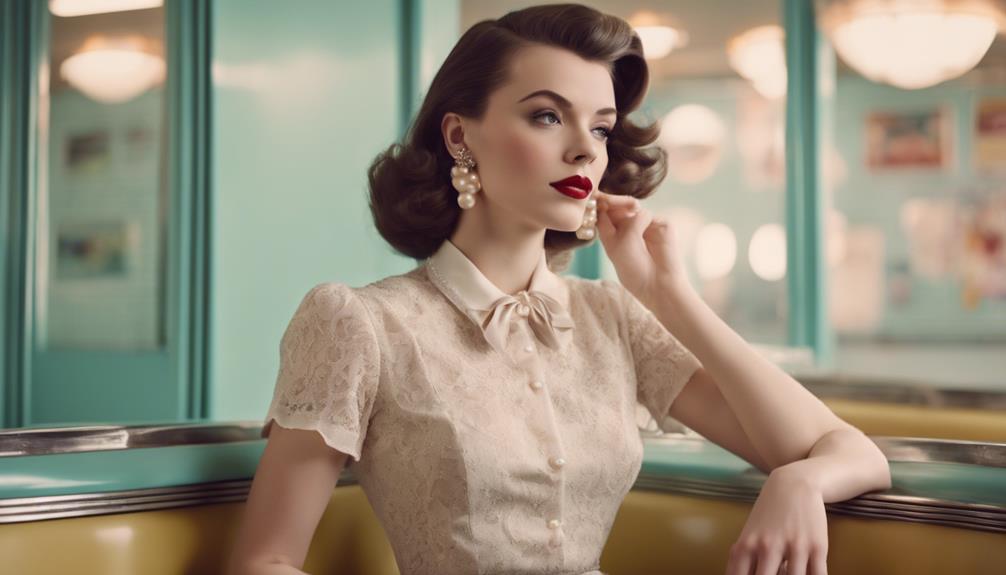
When you explore 1940s fashion, you'll notice signature silhouettes and eye-catching patterns that defined the decade.
Rich textures and earthy hues enhance the overall look, giving garments a unique charm.
Don't forget to reflect on the timeless accessories and footwear that complete these stylish outfits.
Signature Silhouettes and Patterns
What defines the signature silhouettes and patterns of the 1940s is their ability to flatter diverse body types while exuding timeless elegance. You'll find that A-line dresses and high-waisted trousers are classic elements that enhance your figure, making them staples in vintage clothing. These designs not only celebrate femininity but also provide comfort and style for any occasion.
As you explore vintage fashion, you'll encounter popular patterns like polka dots and bold florals. These iconic prints, reminiscent of the 1950s and 1960s, add a playful touch to modern outfits, effortlessly blending past and present. The intricate details found in these garments, such as ruffles, bows, and embroidery, showcase the artistry that vintage clothing embodies.
Moreover, the luxurious fabrics—like silk, lace, and velvet—elevate these signature silhouettes, enhancing their opulence. This cyclical nature of fashion guarantees that these timeless elements remain relevant today, as contemporary designers consistently draw inspiration from the elegance of the past.
Embracing these silhouettes and patterns not only celebrates history but also allows you to express your unique style with confidence.
Rich Textures and Earthy Hues
Incorporating rich textures and earthy hues into your wardrobe instantly elevates your style, adding depth and a touch of luxury reminiscent of vintage fashion.
Think of fabrics like velvet, silk, and brocade that evoke a sense of opulence, embodying the timeless elegance of past eras. Earthy hues such as olive green, rust, and mustard aren't just on-trend; they establish a connection to nature, bringing warmth and sophistication to your fall outfits.
The beauty of blending rich textures with earthy tones lies in their versatility. You can effortlessly shift from casual outings to formal events while maintaining that vintage-inspired allure. Patterns that incorporate these earthy colors, like floral and paisley prints, enhance your ensemble, infusing it with nostalgia and visual interest.
Moreover, opting for textured fabrics in earthy shades promotes sustainability, encouraging the use of quality materials that endure beyond fast fashion trends. By embracing this combination, you not only elevate your wardrobe but also contribute to a more sustainable approach to fashion.
Timeless Accessories and Footwear
Timeless accessories and footwear effortlessly elevate your vintage-inspired outfits, adding elegance and sophistication that never go out of style. Incorporating classic pieces like pearl necklaces and vintage brooches can instantly enhance your look, bringing a touch of nostalgia and charm. These timeless accessories reflect classic styles from the past, making them essential for any retro ensemble.
When it comes to footwear, you can't go wrong with classic pumps or Mary Janes. Both styles provide comfort and a refined silhouette that complements your vintage-inspired attire. The right pair of pumps can transform your outfit, making you feel poised and stylish.
Structured handbags, such as box bags and satchels, also play a vital role in achieving that polished finish. They add sophistication and serve as the perfect complement to your overall aesthetic. Don't forget about the impact of vintage-inspired belts; those with unique buckles can define your waist and add visual interest.
Lastly, a pair of cat-eye sunglasses evokes the glamour of the 1950s, offering a chic touch that completes any outfit. By curating these timeless accessories and footwear, you'll embody elegance and sophistication effortlessly.
Modern Interpretation
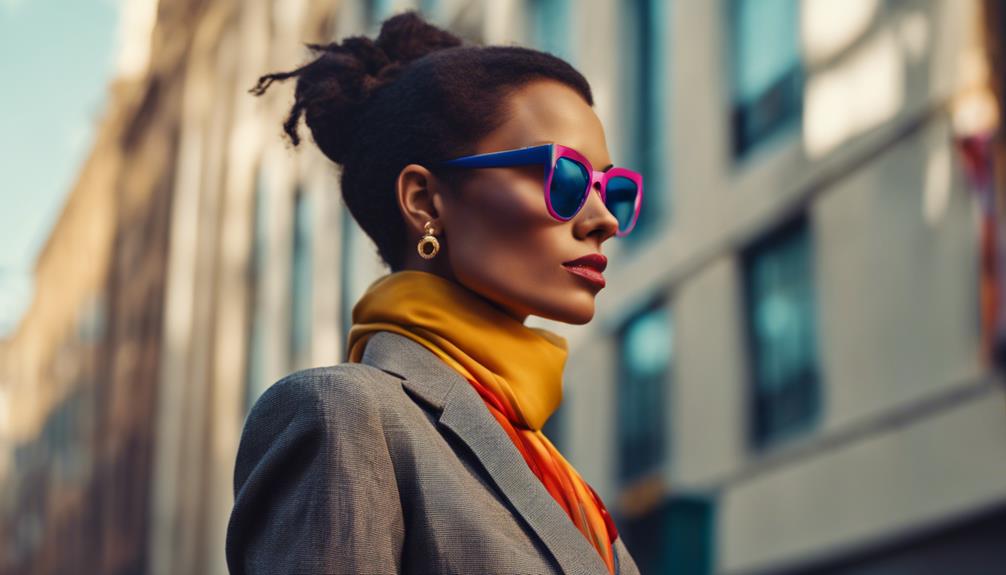
When you look at modern vintage styles, you'll notice how designers blend classic elements with today's trends.
Iconic labels from the past and fashion icons of the 1960s continue to inspire contemporary collections, making vintage pieces feel fresh.
This fusion keeps the essence of 1940s fashion alive while appealing to your modern sensibilities.
Modern Vintage Style Influences
Modern vintage style influences blend classic silhouettes with contemporary elements, creating looks that resonate with today's fashion sensibilities.
You'll find timeless appeal in vintage-inspired pieces, like A-line dresses and bell bottoms, reimagined with modern flair through updated fabrics and cuts. This approach allows you to infuse nostalgia into your wardrobe while still feeling current.
The resurgence of retro prints, such as polka dots and bold florals, offers a fresh way to express your individuality. This trend not only celebrates past styles but also encourages you to mix and match, making these pieces your own.
Furthermore, sustainable fashion practices, like upcycling vintage garments, have become increasingly popular. By choosing quality over fast fashion, you contribute to an eco-conscious lifestyle while enjoying unique styles.
Social media plays a significant role in promoting these vintage aesthetics, as influencers and celebrities showcase their vintage-inspired outfits, making them aspirational for younger generations.
E-commerce platforms and curated vintage boutiques have made it easier for you to discover high-quality, one-of-a-kind pieces that reflect your personal fashion preferences, ensuring that modern vintage style remains accessible and relevant.
Iconic Vintage Fashion Labels
Iconic vintage fashion labels like Dior and Chanel continue to shape your wardrobe choices, blending classic designs with contemporary flair. These timeless brands lay the foundation for modern interpretations that celebrate vintage elements while appealing to today's sensibilities.
For instance, Christian Dior's 'New Look' introduced in 1947, with its cinched waists and full skirts, remains a powerful symbol of femininity, frequently reimagined in current collections.
Yves Saint Laurent and Emilio Pucci also play significant roles, with their bold prints and vibrant colors inspiring playful takes on elegance. You'll find that the craftsmanship and quality associated with these iconic vintage fashion labels have sparked a resurgence in luxury second-hand markets. Consumers are increasingly drawn to authentic pieces as sustainable fashion choices.
Modern designers often weave retro silhouettes and luxurious fabrics into their collections, paying homage to the timeless elegance of the past. This fusion of vintage and contemporary styles allows you to express your unique fashion identity while celebrating the rich heritage of iconic labels.
Embracing these elements guarantees your wardrobe remains both stylish and sophisticated.
Fashion Icons of the 1960s
Building on the timeless influence of vintage labels, fashion icons of the 1960s like Audrey Hepburn and Jackie Kennedy brought forth silhouettes that still shape today's style landscape.
You'll find that their iconic A-line dresses and tailored suits continue to serve as timeless pieces in modern wardrobes. Fashion enthusiasts often look to these retro styles for inspiration, blending them with contemporary elements for a unique flair.
The 1960s also introduced bold prints and colors, thanks to designers like Mary Quant, who popularized the mod look. Today, you can embrace this vibrant aesthetic by incorporating geometric patterns into your outfits.
Don't forget the importance of statement accessories, like oversized sunglasses, which add a touch of retro elegance to any look.
Mini skirts and shift dresses, once symbols of youth culture and rebellion, have made a significant comeback. By pairing these pieces with modern accessories, you celebrate the past while staying current.
Designers like Pierre Cardin and André Courrèges experimented with space-age influences, inspiring today's blend of nostalgic and futuristic styles.
Styling Tips

When it comes to styling your 1940s-inspired outfits, mixing vintage accessories with modern pieces can really elevate your look.
You'll want to explore layering techniques that add depth and personality to your ensemble.
Key Vintage Accessories
Vintage accessories can effortlessly elevate your outfit, adding charm and sophistication to your overall look. To achieve that timeless elegance, consider incorporating a classic pearl necklace. This versatile piece complements vintage-inspired styles and suits any occasion.
Cat-eye sunglasses are another must-have; they not only evoke a retro vibe from the 1950s but also serve as a chic statement piece that enhances your overall vintage aesthetic. Pair these with structured handbags, which are essential for achieving a polished style. Their classic shapes and high-quality materials elevate both casual and formal outfits.
Don't overlook the power of vintage-inspired accessories like brooches and statement belts. These pieces can transform modern ensembles into eye-catching outfits that truly reflect your personal style.
For added dimension, try layering necklaces of varying lengths and styles. This technique creates a visually appealing effect, enhancing your vintage-inspired outfits.
Vintage Layering Techniques
Incorporating vintage layering techniques can bring a fresh twist to your wardrobe, allowing you to express your unique style while enhancing your overall look.
Start with a base layer like a fitted turtleneck or a classic button-up shirt, which serves as a versatile foundation for various outfits. Mixing textures is key; pair a silk blouse with a wool cardigan or denim jacket to add depth and interest.
Don't shy away from playing with lengths—layer a cropped vintage jacket over a longer dress or tunic to create an eye-catching silhouette.
When it comes to accessories, accessorize wisely with vintage scarves or statement brooches; these can elevate your outfit, reflecting your personal style.
Combining Eras for Unique Looks
Mixing eras in your wardrobe can create standout outfits that reflect your unique style and appreciation for fashion history. To achieve this, start by pairing vintage pieces, like a 1970s bell-bottom, with contemporary items, such as a fitted top. This combination showcases your personal flair while honoring timeless elegance.
Incorporating retro prints—think polka dots or bold florals—into modern silhouettes adds whimsy and character, resulting in a perfect blend of eras. Layering vintage accessories, like a classic pearl necklace, with a contemporary dress can elevate your look and introduce a sophisticated touch reminiscent of past styles.
Opt for timeless silhouettes, such as A-line skirts or tailored blazers, which flatter various body types and seamlessly shift between vintage and modern wardrobes. Don't shy away from experimenting with color palettes from different decades; soft pastels from the 1950s or earthy tones from the 1970s can enhance your outfit's overall aesthetic.
Shopping Guide
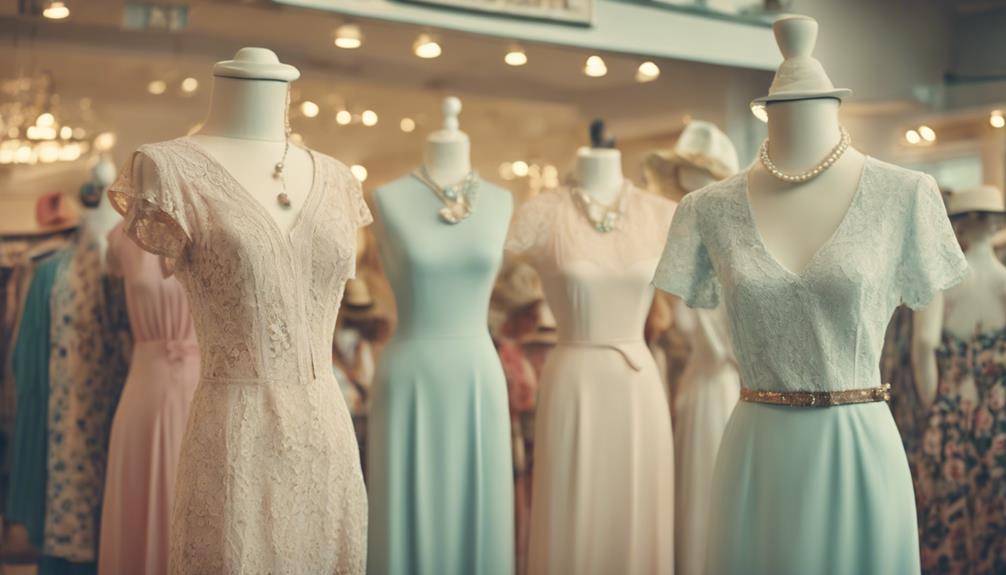
When you're on the hunt for 1940s fashion, it's essential to explore specialized shops and online platforms that offer curated selections of timeless pieces. Look for vintage shops, thrift stores, and platforms like Etsy and Depop for unique finds that embody the timeless beauty of the era.
Pay attention to sizing, as vintage sizes often differ from contemporary ones. Always take your measurements and consult size charts specific to the 1940s to guarantee a perfect fit.
As you search for vintage pieces, focus on key characteristics such as high-quality fabrics like silk and lace, iconic floral and polka dot prints, and flattering silhouettes that enhance your figure.
Don't forget to take into account the sustainability aspect of your purchases. By choosing vintage items, you're not only embracing timeless elegance but also extending the lifecycle of garments and reducing waste—an important step in the eco-friendly movement in fashion.
Upcycling Vintage Garments

You can breathe new life into vintage garments through restoration techniques that fix wear and tear.
By adding unique patches, you'll personalize your pieces and showcase your individual style.
This creative approach not only revives old clothes but also makes a statement about sustainability in fashion.
Vintage Garment Restoration Techniques
Upcycling vintage garments breathes new life into cherished pieces, allowing you to creatively transform them while embracing sustainable fashion practices. By focusing on restoration techniques, you can enhance the aesthetic appeal and usability of these timeless items, all while preserving their vintage charm.
Start with patching—this method not only repairs any damage but can also add unique character. When dyeing, choose colors that complement the original design, and use gentle detergents to care for delicate fabrics. Altering fits can make a vintage piece more contemporary, ensuring it meets your style needs.
Incorporating vintage-inspired elements, like lace or embroidery, can enhance the garment's original detailing while giving it a fresh twist. Remember, it's all about attention to detail; every stitch counts.
The beauty of upcycling vintage garments lies in your ability to create one-of-a-kind pieces that reflect your personal style while promoting sustainability. As you invest time and creativity into these projects, you contribute to a circular economy, reducing textile waste and redefining fashion for the better.
Embrace the journey of restoration—you'll love the results!
Personalize With Unique Patches
Adding unique patches to vintage garments instantly personalizes your style and showcases your creativity. By upcycling vintage clothing, you not only enhance its look but also promote sustainability, extending the life cycle of your favorite pieces and reducing textile waste.
You can source custom patches from various materials, allowing for creative expression with different textures, colors, and designs that reflect your individual tastes. This practice has roots in historical subcultures, with punk and DIY movements using patches as a form of rebellion and self-expression.
Incorporating these unique patches into your vintage clothing can even increase its value. Collectors and fashion enthusiasts often seek out one-of-a-kind pieces with personalized touches. Plus, many brands and artisans now offer eco-friendly patches made from recycled materials, aligning perfectly with the growing demand for sustainable fashion choices in contemporary wardrobes.
Cultural Impact
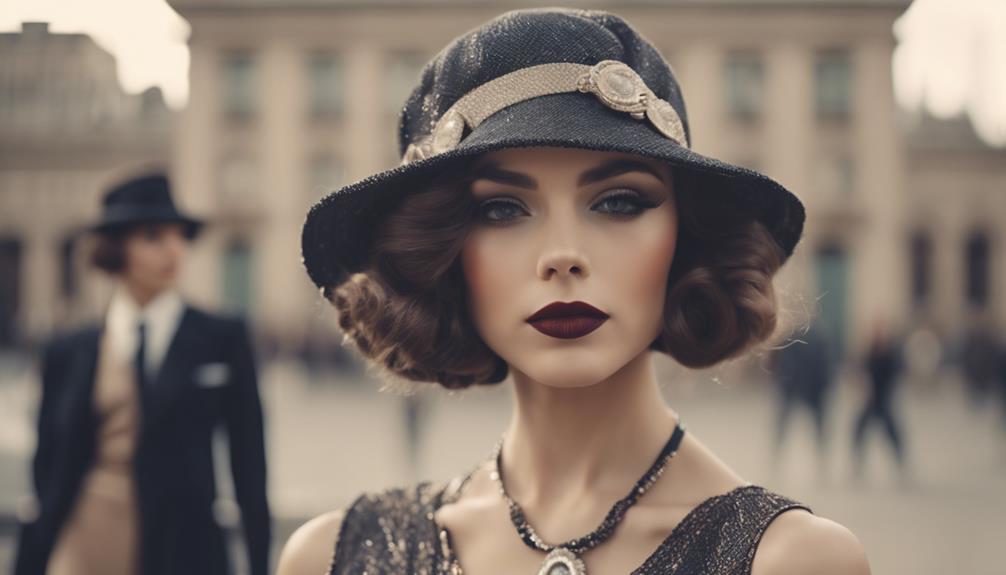
The cultural impact of 1940s fashion is evident in how it shaped the styles of iconic film stars in the 1960s, influencing a generation's sense of identity.
As counterculture movements emerged, fashion activism became a powerful tool for self-expression and social change.
You'll see how these elements not only celebrate individuality but also reflect the ongoing dialogue between past and present fashion trends.
Influence of 1960S Film Icons
Influenced by the iconic styles of 1960s film stars, fashion underwent a dramatic transformation that shaped cultural narratives and personal expression during the era.
You can see the vintage elegance in Audrey Hepburn's portrayal of Holly Golightly in 'Breakfast at Tiffany's,' which popularized the little black dress and oversized sunglasses. This timeless style continues to inspire modern wardrobes, proving that classic looks never truly fade away.
Brigitte Bardot also left a significant mark, introducing a casual yet alluring aesthetic with her off-the-shoulder tops and high-waisted skirts. Her influence is evident in today's fashion trends, where comfort meets chic sophistication.
The films of the 1960s weren't just about individual style; they reflected broader cultural revolutions, making fashion an essential part of social narrative.
As you explore current fashion, you'll notice how designers frequently draw on the classic silhouettes and bold statements of these film icons, creating a bridge between past and present.
The cultural impact of 1960s film stars confirms that elegance and style are timeless, allowing you to express yourself with confidence and flair, inspired by the legends of the silver screen.
Counterculture and Fashion Activism
During the 1960s and 70s, fashion became a powerful tool for counterculture movements, allowing individuals to challenge societal norms and express their political beliefs through their clothing choices.
Fashion activism emerged as a significant force, with groups like hippies and punks using vintage fashion to protest against mainstream values. Styles such as bell bottoms and tie-dye weren't just trends; they symbolized individuality and rebellion.
Today, this spirit of counterculture continues in modern fashion activism, where sustainability is a central theme.
Vintage enthusiasts advocate for reducing waste by promoting secondhand shopping and reusing garments, making a statement against fast fashion's environmental impact.
Events like Fashion Revolution Day highlight the importance of ethical practices, encouraging consumers to question where their clothing comes from.
Frequently Asked Questions
What Fashion Style Is Timeless?
Timeless fashion styles often blend classic silhouettes and luxurious fabrics, creating looks that flatter every figure. Incorporating vintage-inspired prints and elegant accessories, you can effortlessly achieve a sophisticated appearance that transcends trends and seasons.
What Are the Styles of Retro Fashion?
Retro fashion includes styles like flapper dresses, A-line skirts, and bell-bottom pants. You'll find vibrant prints, luxurious fabrics, and iconic accessories like cat-eye sunglasses that give your outfits a nostalgic yet stylish edge.
What Is Vintage Elegant?
Vintage elegance is all about timeless fashion that incorporates classic silhouettes, luxurious fabrics, and intricate detailing. You'll find soft colors, feminine shapes, and statement accessories that elevate your style and celebrate sophisticated, bygone eras.
What Is the Difference Between Retro and Old Fashioned?
You're looking at retro as styles that embrace nostalgia while updating for modern appeal. In contrast, old-fashioned refers to outdated fashions without contemporary relevance. Retro's cyclical nature keeps it fresh, unlike static old-fashioned garments.
Are 1930s fashion trends still relevant and stylish in today’s fashion industry?
Vintage 1930s fashion glamour captivates the modern fashion industry with its timeless elegance and sophistication. Many design elements from that era such as bias-cut dresses, wide-leg trousers, and tailored suits continue to influence today’s fashion trends. The allure of 1930s fashion still resonates with designers and fashion enthusiasts alike.
Conclusion
Embracing 1940s fashion lets you tap into a timeless elegance that never goes out of style.
Whether you're rocking a tailored suit or a classic tea dress, these retro pieces can elevate your wardrobe.
Don't hesitate to mix modern elements with vintage finds, and remember, upcycling is a fantastic way to breathe new life into old garments.
So go ahead, channel that vintage charm and make it your own—after all, style is all about expressing who you are!
